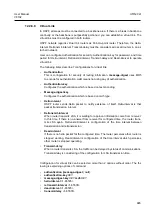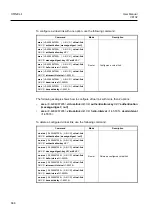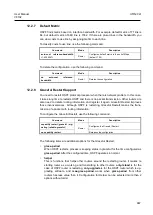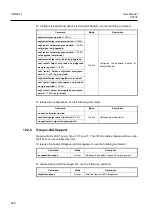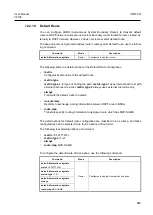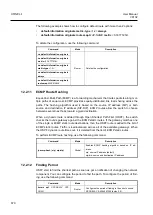
User Manual
UMN:CLI
V8102
679
12.3
Open Shortest Path First Version 3 (OSPFv3)
OSPF for IPv6 modifies the existing OSPF for IPv4 to support IPv6. The fundamentals of
OSPF for IPv4 remain unchanged. Some changes have been necessary to accommodate
the increased address size of IPv6 and the changes in protocol semantics between IPv4
and IPv6. OSPF for IPv6 is defined in RFC 2740, which emphasizes the differences be-
tween OSPF for IPv4 and OSPF for IPv6. It contains a large number of references to the
documentation of OSPF for IPv4, which makes it hard to read. This chapter tries to con-
catenate the two worlds to make the reading a little bit more comfortable. It starts with an
overview of OSPF, including the area structure and external routes. After the overview, it
opens up the protocol to get down to the implementation details: it starts with the OSPF
message format, proceeds to the neighbor relationship, and finishes with the actual link
state database and the calculation of the routing table.
The followings are differences between OSPF for IPv4 and OSPF for IPv6.
-
Protocol processing per-link, not per-subnet
IPv6 connects interfaces to links. Multiple IP subnets can be assigned to a single link
and two nodes can talk directly over a single link, even if they do not share a com-
mon IP subnet. OSPF for IPv6 runs per-link instead of per-subnet. The terms "net-
work" and "subnet" used in OSPF for IPv4 should be replaced with the term "link";
e.g., an OSPF interface now connects to a link instead of an IP subnet.
-
Removal of addressing semantics
IPv6 addresses are no longer present in OSPF packet headers. They are only al-
lowed as payload information. Router-LSA and Network-LSA (yes, they still exist) do
not contain IPv6 addresses. OSPF Router ID, Area ID, and Link State ID remain at
32 bits, so they can no longer take the value of an IPv6 address. Designated Routers
(DRs) and Backup Designated Routers (BDRs) are now always identified by their
Router ID and no longer by their IP address.
-
Use of link-local addresses
OSPF assumes that each interface has been assigned a link-local unicast address.
All OSPF packets use the link-local address as the source address. The routers
learn the link-local addresses of all their neighbors and use these addresses as the
next hop address. Packets sent on virtual links, however, must use either the global
or site-local IP address as the source for OSPF packets.

